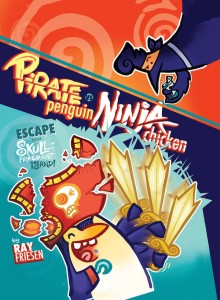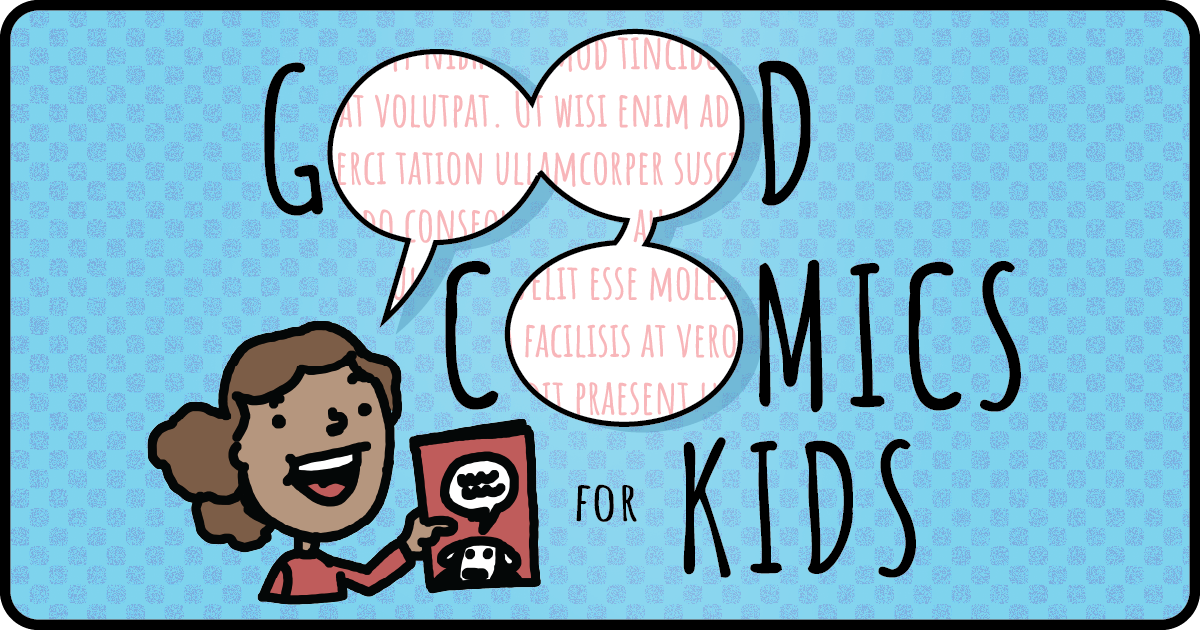
Interview: Ray Friesen on Pirate Penguin and Ninja Chicken
 Ray Friesen’s Pirate Penguin vs. Ninja Chicken (Book 2): Escape from Skull Fragment Island! debuts today. Friesen has been making comics for a long time—he was first paid for his work, as he explains below, when he was just four years old. Now a grownup, he has a number of comics and graphic novels to his credit, and we talked to him about why he likes silly stories, how he does his job, and what he does when he’s not making comics. Be sure to check out our preview of Pirate Penguin vs. Ninja Chicken (Book 2): Escape from Skull Fragment Island! so you can see just how silly it gets!
Ray Friesen’s Pirate Penguin vs. Ninja Chicken (Book 2): Escape from Skull Fragment Island! debuts today. Friesen has been making comics for a long time—he was first paid for his work, as he explains below, when he was just four years old. Now a grownup, he has a number of comics and graphic novels to his credit, and we talked to him about why he likes silly stories, how he does his job, and what he does when he’s not making comics. Be sure to check out our preview of Pirate Penguin vs. Ninja Chicken (Book 2): Escape from Skull Fragment Island! so you can see just how silly it gets!
Pirate Penguin and Ninja Chicken are very silly. What can you tell our readers about these characters and what inspired them?
Pirate Penguin and Ninja Chicken are very silly because I am very silly. Silly has always been my favorite variety of comedy, because it can range from silent slapstick to sarcastic witticisms, all the while remaining upbeat and bombastic. Inspiration includes Bugs Bunny cartoons, Walt Kelly’s Pogo comic strip, and Monty Python’s Flying Circus. Plus a bunch of other things. I’ve been drawing penguins and pirates forever, and a few years ago, it finally occurred to me to combine the two and I’ve never looked back. I think Pirate Penguin is a distillation of all my favorite character traits, so his voice comes to me very easily. He’s loud, and he always knows what he wants. He has all the wisdom and self restraint of a five-year-old, but he also has a big sharp sword. Ninja Chicken seemed the natural foil for him. I like flightless birds, so it could have easily been Ninja Kiwi or Ninja Ostrich. I think the “Pirates vs Ninjas—who will win?” debate was raging at the time. I didn’t want to see either win. It’s like asking who will ultimately win the Mad Magazine comic “Spy vs Spy”—it doesn’t really matter. My Pirate and Ninja are roommates, an odd couple, trying to put aside their petty differences, and usually failing to do so.
ADVERTISEMENT
ADVERTISEMENT
What’s your favorite sort of story to write about them? What sort of adventures do you like to send them on?
Generally, I just plop the two of them into a mundane situation, like a grocery store, and watch them demolish everything. Pirate Penguin effectively writes his own dialogue, so I don’t have to do concentrate. I just have to think of places for them to go. The short stories are much quicker and easier than the long “tentpole” story that occupies the second half of the book, because I can resolve them as soon as they stop being funny, rather than when I run out of plot. Generally Pirate Penguin just runs away from whatever problem he’s caused. He’s not a very good role model, but I do I like to send the pair of them out into the world, to make weird new friends, which is certainly something everyone should do.
A lot of your stories have jokes that adults will enjoy as well, such as the one that’s set in the Swedish department store Vikea. Who are you thinking about as your readers when you make these comics?
The person I have in mind when I’m writing is very firmly ME. I’m not trying to write Kids-Comics-That-Adults-Enjoy-Too, I’m writing Raymond-Comics-That-If-Anyone-Else-Enjoys-That’s-Just-A-Bonus. If I can’t make myself laugh, then why bother? I love revisiting books and movies I enjoyed as a kid, and understanding a whole new wave of jokes I didn’t appreciate the first time. It adds a richness to whatever the creative endeavor is, and I’m hoping to do the same with my work. If it seems like I’m doing something intentionally, that just shows how good I am at tricking everyone.
Do you like to write first or write and draw at the same time?
I like to write first. I can’t type my ideas to start with, I scribble them fiercely on whatever paper I can find, usually embellished with doodles. I have very dialogue heavy comics, so I need a strong sense of what’s going on before I can start drawing. Once I have it mostly figured out, I’ll begin penciling. Almost always I’ll put in a background gag, or a weird-looking facial expression, and that will open up new little avenues for the comic to follow, and so extra funny bits are added during this stage. I like to have a map before I set out on the adventure. I can take detours or shortcuts, or even go someplace else entirely, but at least I know where I’m trying to go.
I read that you first sold your work when you were four years old! Can you tell us about that?
ADVERTISEMENT
ADVERTISEMENT
I have indeed been a professional since the age of 4—because that was the first time I got paid for my art! That’s all it really takes to be a pro, y’know. My parents owned a T-shirt shop, and my mom did all the graphics. She encouraged me to be creative from the get-go, and that made trying to make a career out of being creative considerably easier. I hear horror stories of people whose parents wanted them to grow up and become practical, and I’m so glad I didn’t have to deal with any of that. Anyway! Four years old, living in the T-shirt shop, and we were contacted by the local wind-energy company Zond (now owned by G.E.) to design some kid-tastic animal characters for their marketing campaign “Clean Energy For Everyone”—this was in the early 90s, so not everybody was excited about Green Power yet. I did as I was asked, drawing horses and cows and chickens with crayons in both hands—and they used the image all over the place. It was very impressive to be four years old and see something you’d designed on giant billboards, on novelty wind toys, and printed on people’s torsos. Probably why I have such an enormous ego to this day!
Have you ever thought of being anything other than a cartoonist?
I picked cartooning as my career because it meant I got to write stories and draw pictures, which is about all I’ve ever wanted to do—that doesn’t mean I couldn’t direct a movie or write a novel or build a labyrinth full of secret hieroglyphics and deadly traps—it’s all using pictures and words to tell stories, and that’s what I love doing. Even when I’m not actively creating a comic strip, I am gathering ideas and inspiration for future comics. I could spend time as a cheese technician, or mustache polisher, or a disguised member of an all-lobster orchestra—and I’m sure the experience would work its way into a comic. So no, I’ve never really thought of not being a cartoonist, because being a cartoonist doesn’t prevent me from doing anything else I might be interested in at the time. Plus I hate waking up in the morning and putting on pants, which is required for most jobs.
What’s your favorite part of your job?
My favorite part of the job is making myself laugh. I just get the giggles and end up flailing around on the floor, which is now a part of my exercise regimen. 25 floor-giggles a day and I’d lose all this unsightly flab and probably become immortal. Second favorite part of the job is when other people tell me that they laughed at something I made—because this is confirmation that I’m not crazy and it actually is funny. Least favorite part of the job—there’s a lot of business stuff that needs to be done, like phone calls, invoices, web design, that I wish would get done magically. I’m scared of phone calls.
What have you learned over the years?
What have I learned? Ooh, that’s a toughie, because now I have to remember all the things I didn’t know and compare them to what I’m pretty sure I know now. I’ve always been talented, but over the years I’ve been trying to acquire skills, which are far more useful than talent. I’m pretty focused, I have a firm idea of what I’m trying to accomplish creatively, but I’m always hoping to improve my techniques. Experimenting, doing something you wouldn’t normally do, is a big part of artistic growth, and I’m trying to find the time for that. I love talking to other creative people, and picking up new methods via osmosis. I taught myself how to be more personable (I used to be shy, if you can believe it). I’m trying to become a better collaborator. I usually already have the final product in my head, and then I just have to spend a few months putting it on paper—working with someone else, they have visions in their heads too and you have to weld those notions together without hurting anybody’s feelings. Not always easy. I’ve learned that I’m not going to “go viral” any time soon, to stop waiting around for fame to get emailed to me, and that being active on social media is a full time job. I think mostly I’ve learned, that even if I don’t know what I’m doing (which is most of the time) I have the tools to fake it until I figure it out. Also, now that I have a son (18 months, and far more energetic than I am!) I look forward to sharing all the things, books and comics and movies and toys that I love with him, and seeing what he might teach me. He’s really good at biting, but I’m pretty sure I already know how to do that…
Filed under: Interviews
About Brigid Alverson
Brigid Alverson, the editor of the Good Comics for Kids blog, has been reading comics since she was 4. She has an MFA in printmaking and has worked as a book editor, a newspaper reporter, and assistant to the mayor of a small city. In addition to editing GC4K, she is a regular columnist for SLJ, a contributing editor at ICv2, an editor at Smash Pages, and a writer for Publishers Weekly. Brigid is married to a physicist and has two daughters. She was a judge for the 2012 Eisner Awards.
ADVERTISEMENT
ADVERTISEMENT
SLJ Blog Network
Fuse 8 n’ Kate: Tops & Bottoms by Janet Stevens
It’s Time for More Mock Newbery Suggestions
Navigating the High School and Academic Library Policy Landscape Around Dual Enrollment Students
Book Review: The Secret Library by Kekla Magoon
ADVERTISEMENT







